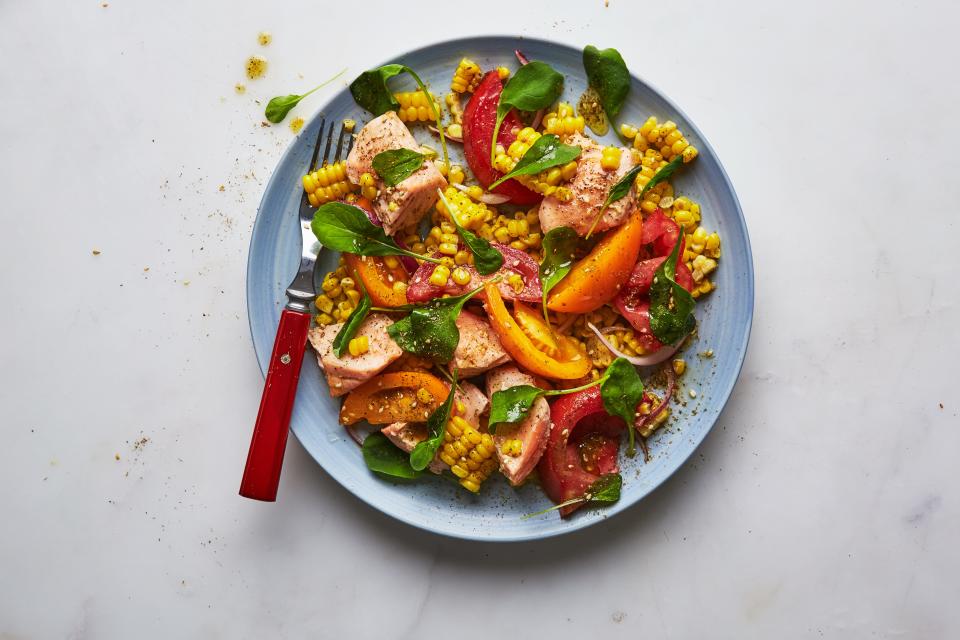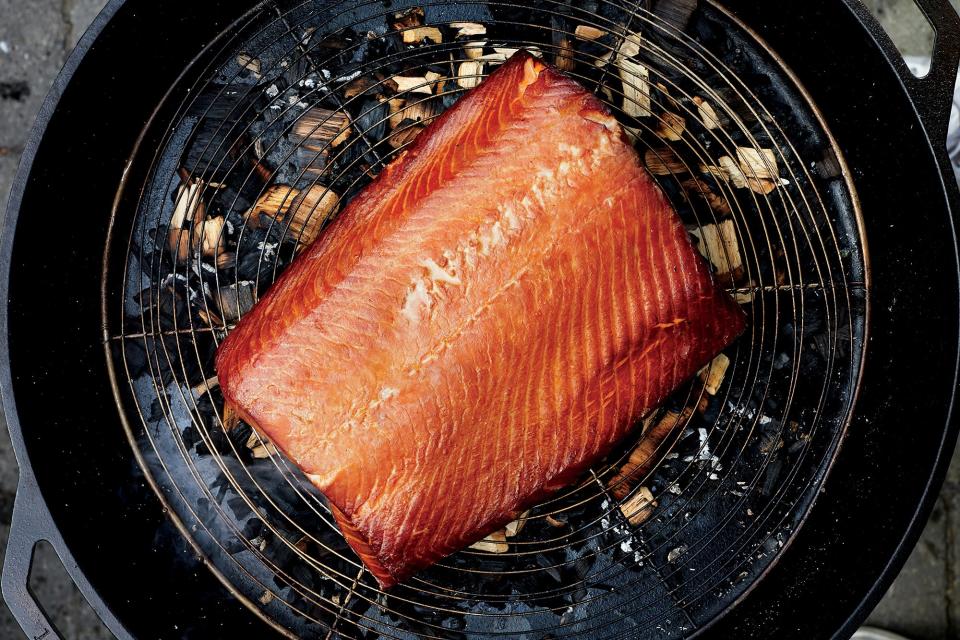How to Cook Salmon So It Always Comes Out Perfectly
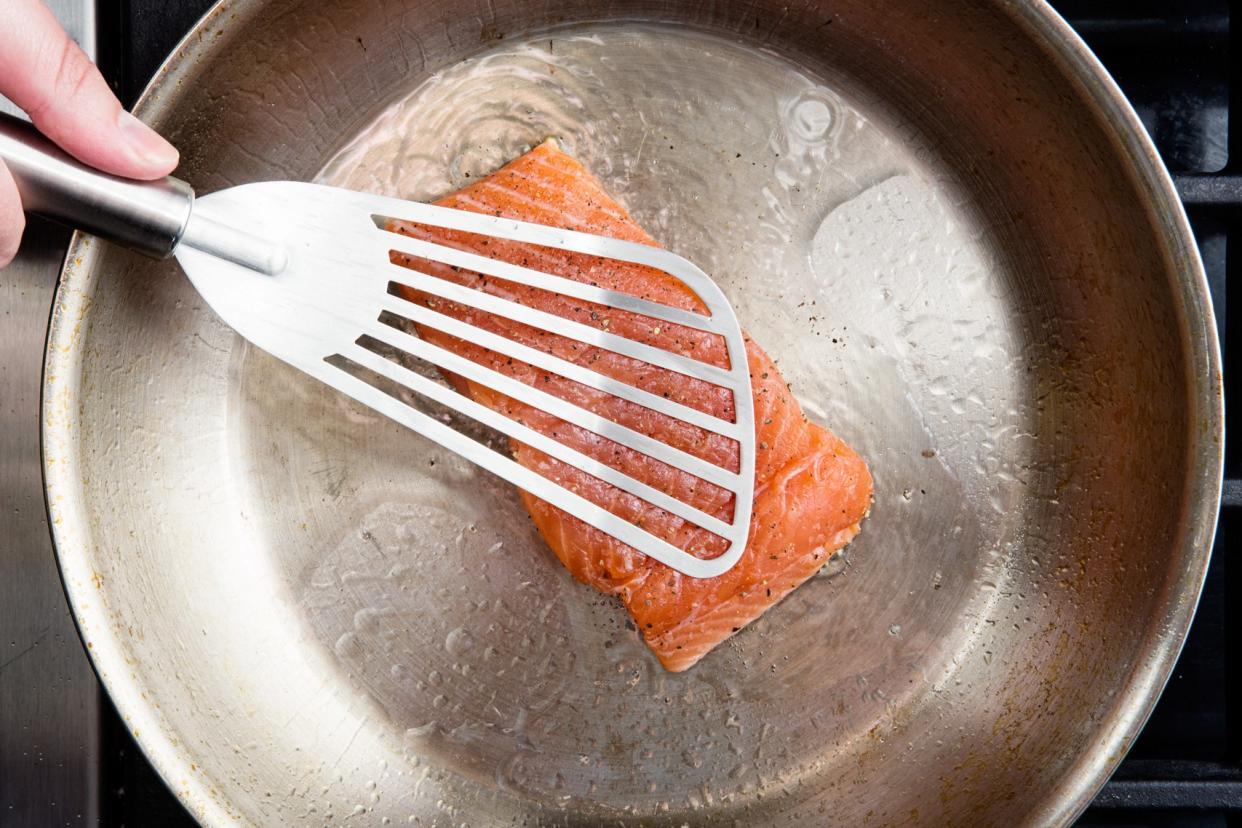
Buttery, meaty, and full of good-for-you fats, salmon lies in that magical realm of foods that are both healthy and truly delicious. It's also very easy to cook. Whether you prefer your salmon seared and crisp-edged, gently poached, thrown on the grill, or—our favorite—slow-roasted to a perfect finish, here's what you need to know when cooking it.
But first, a tip: When considering how to cook salmon perfectly, the real trick is to buy a great piece of fish in the first place. Depending on the season and type of salmon, the color could range from pale pink to vibrant coral, so don't let hue play too much into your decision. Instead, look for plump, moist flesh. The skin, if you can see it, should be shiny, but not slimy. If the fillets look dull, greyish, or if they're sitting in a watery shrink-wrapped pool, avoid salmon entirely and go for another piece of fish that looks like a better, fresher buy. And finally, don't forget, if you don't live near a coast, the frozen aisle could be the best place for you to find the best seafood.
1. How to bake salmon fillets
Cooking salmon fillets in a low oven (around 300°F) results in a hands-off preparation that takes little more than 20 minutes start to finish. Salt and pepper will get the seasoning job done if you're in a real rush; but, for added interest, take 30 seconds to toss breadcrumbs with oil and sprinkle the mixture over each Dijon-brushed fillet before sliding it into a pre-heated oven. Since this method won't crisp the skin, the breadcrumbs add a crunchy element to the finished dish. No breadcrumbs? Rub fillets in vibrant spice mix and top with relish or salsa instead.
You'll know the salmon is done with you can press the fillet with your finger or a silicone spatula and you see it easily start to flake apart. If you see a white substance starting to ooze from the sides, take the salmon out, that's a sign your fish is starting to overcook.
Baked Mustard-Crusted Salmon with Asparagus and Tarragon
2. How to slow-roast salmon for a crowd
Don't let the name fool you. Slow-roasting fish is still a relatively quick (and easy) process that results in tender, succulent, flaky fish with an impressive presentation. To do it, thinly slice any vegetables and aromatics you like—such as fennel, citrus, and chiles or herbs and cherry tomatoes—toss them with oil, salt, and pepper, and pile them onto a sheet pan. Next, season a whole, center-cut, skinless piece of salmon—about 1/3 pound for each person you'll be serving—simply with salt and pepper (or coat the fish with a flavorful harissa rub), place it on top of the vegetables, and drizzle with more oil. Slide the whole thing into a 275°F to 300°F oven and cook until the salmon is firm to the touch and flakes lightly when you press the center, about 40 minutes depending on the size of your fish.
If you want to serve this for a care-free summer dinner, roast the day before you plan to eat it and serve chilled with smashed green beans and plenty of rosé.
Cold Roast Salmon with Smashed Green Bean Salad
Bon Appétit
3. How to pan-sear salmon for crispy skin
Making crispy-skinned salmon at home may seem like an elusive dream; it's the kind of fish you'd think you could only eat at restaurants. But with a little know-how and a few tricks—as my colleague Anna Stockwell details here—it doesn't have to be so intimidating. Just make sure you have a flexible fish spatula and a little patience and your dreams can become reality.
A few things to remember: you'll cook the fish almost entirely on the skin side so that it has plenty of time to get crispy, just flipping it over for the final 30 seconds to sear off the second side. For added insurance, make sure the skin is totally dry and then dust it with a bit of flour or cornstarch right before it hits the hot oil. Finally, serve the fish skin-side-up on top of anything juicy or saucy—drizzling the skin with anything wet will eliminate any crispiness you went to such lengths to achieve.
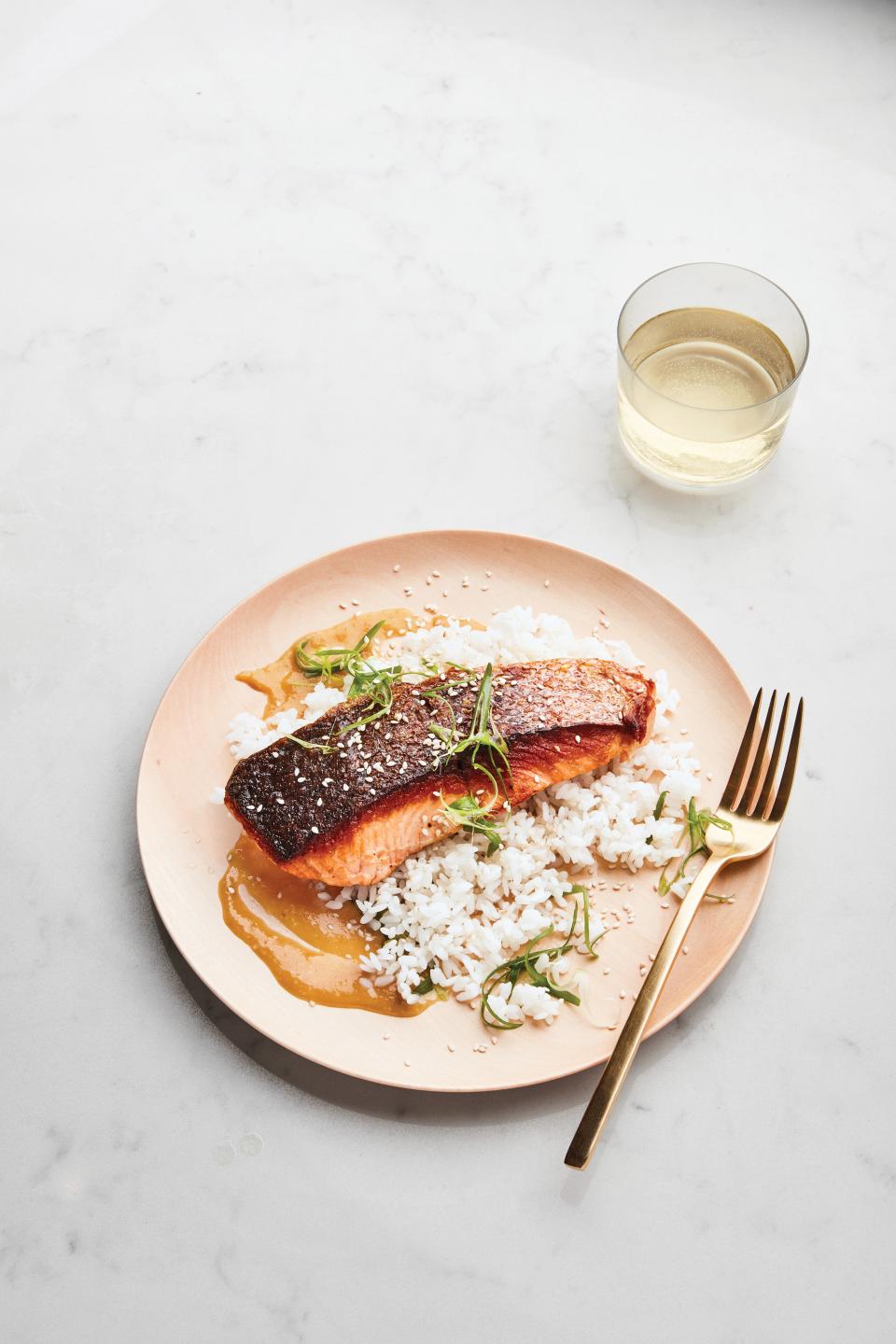
Crispy-Skin Salmon with Miso-Honey Sauce
4. How to cook salmon using the cold-pan method
Another way home cooks can achieve crispy-skinned salmon is to place the seasoned fish skin-side down in a cold pan. The pan is then placed over medium heat. As the pan warms up, the fat is gradually rendered from the salmon skin. As above, the fish is cooked almost entirely on one side. After 10 minutes, the fillets are flipped (there should be no resistance; if the skin is sticking to the pan leave it a little longer and gently press down on the fillet to make sure it's making full contact with the pan) so that the flesh side of the fish is just kissed with a little heat. It's best to use cast iron, carbon steel, or a non-stick surface when attempting to use this method.
Crispy Fish with Brown Butter Sauce and Kohlrabi Salad
Bon Appétit
5. How to poach salmon
Anna covered this topic for us too when she unveiled a fantastic, easy salmon and corn salad supper. To poach salmon, fill any pan with water, stock, or another flavorful liquid—enough to fully submerge your fillets—and toss in some aromatics (bay leaves, lemon halves, herb sprigs, etc.) while you're at it. You want to go skinless here since the skin would just become flabby and unappealing after cooking. Once the water boils, lower the heat and slide the fillets into the liquid. They should be fully cooked in about 5 minutes. A great way to check for doneness is to use a cake tester: if the tester slides through the center of the fillet with little to no resistance, it's ready.
Summer Corn, Tomato, and Salmon Salad with Za'atar Dressing
6. How to grill salmon fillets
My favorite way to grill individual portions of salmon is in kebab form. Simply toss cubes of the fish with a flavorful spice mix and thread them onto two skewers (so that turning them is easier) with slices of lemon or lime to perfume the fish with bright flavor. Clean and prep the grill grates and then cook the kebabs over medium heat for 3 to 5 minutes per side.
If you do want to grill whole fillets, the same rules apply: make sure to oil the grill grates and don't go far. Grilled salmon cooks very quickly, and if you're busy attending to a sauce or a side dish, they could go over in the blink of an eye.
Spiced Salmon Kebabs
Bon Appétit
7. How to grill a whole salmon (or at least a larger fillet)
The recipe below includes instructions on how to remove the backbone from a whole salmon prior to cooking, but you really don't have to follow that step. (Plus, it's actually easier to remove the salmon flesh from the bones after cooking.) Either way, stuff the cavity of a whole salmon with sliced lemon and herb sprigs and tie the fish together a few times to keep the aromatics in place. Then cook on the cool side of a two-zone grill for about 30 minutes, flipping the fish at around the 15-minute mark.
Don't want to commit to a whole fish? Grab a large fillet (about 2 pounds), slather it in a honey-mustard glaze, and lay it on a soaked cedar plank. Set the planked salmon over direct, medium-hot heat and grill, covered, for about 15 minutes.
Whole Grilled Salmon with Chanterelles
Bon Appétit
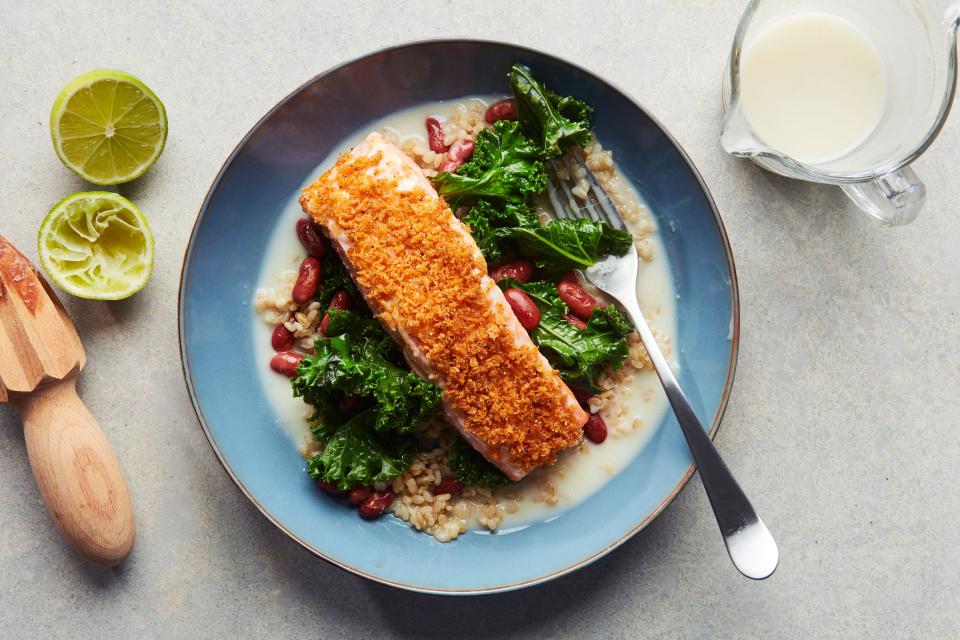
Fast Slow-Cooked-Style Salmon Tricks - RECIPE
8. How to smoke salmon
We'll leave cold-smoked salmon to the professionals, but hot-smoked salmon is pretty easy to achieve. Salt a side of salmon generously and chill for at least three hours, uncovered. Set a cast iron pan on a hot grill—you can choose to do this indoors if you don't have a grill—and add 2 cups of wood chips to the skillet. As soon as the wood is charred, add a few spices and other aromatics, then place a rack over the cast iron. Place the fish on the rack and then cover the whole thing. Cook over medium heat for about 8 minutes, then reduce the heat to low and continue to smoke for 10 to 15 minutes.
Hot-Smoked Salmon with Tarragon Crème Fraîche
Bon Appétit
9. How to broil salmon
To get that grill-like char in the months when it's too cold for outdoor cooking, opt for cooking salmon under your oven's broiler. In this recipe, the salmon is marinated in a mix of honey and soy sauce, but again, salt and pepper will get the job done if that's more your vibe. Make sure to preheat the broiler for several minutes before placing the salmon fillets on a sturdy sheet pan and sliding under the broiler for about 6 minutes. Check it often—the broiler is quick to burn an unattended dinner. Depending on the size of your fillets, you may need to broil a few minutes more.
Broiled Salmon with Scallions and Sesame
Bon Appétit
10. How to stir-fry salmon
Unlike most stir-fries, where you tend to cut the protein into thin pieces, cut salmon into large chunks—they'll inevitably break up a bit during this process, so starting with bigger pieces means you'll be left with satisfying bite-size salmon in the end. Coat the fish with cornstarch and sear the pieces in a hot pan on all sides, then drench in a teriyaki-inspired sauce that will reduce and cling to those salmon pieces, making them sweet, tangy, and incredibly savory.
Spicy Salmon Teriyaki with Steamed Bok Choy
Originally Appeared on Epicurious




